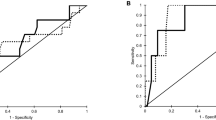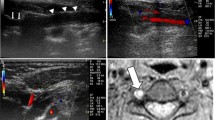Abstract
Purpose
Brain death (BD) is defined as the irreversible destruction of all brain functions. It is usually diagnosed through a clinical examination, but in certain circumstances, ancillary examinations (such as digital subtraction angiography (DSA), transcranial color Doppler (TCD), computed tomography angiography (CTA), magnetic resonance angiography (MRA), or radionuclide scanning) are required as confirmatory tests. In many countries, cervical color Doppler sonography (CCD) is not recognized as a valid test.
The aim of our study is to assess its accuracy as a non-invasive, inexpensive, and easily available examination to determine cerebral circulatory arrest (CCA).
Methods
We performed a retrospective study in which 123 patients with clinical diagnosis of BD underwent bedside cervical color Doppler as an additional examination for CCA assessment. We compared these cervical color Doppler findings with the results of validated ancillary tests such as CTA, TCD, and DSA.
Results
Cervical color Doppler exams showed a sensitivity of 78% (96/123 patients) in detecting CCA compared to standard ancillary tests. Twenty-seven patients showed a persistent diastolic flow in one or two of the four arterial vessels examined and thus considered as false negatives.
Conclusion
Our results show that cervical color Doppler may become a reliable and safe technique in detecting CCA, which can shorten the time for declaring brain death. In particular, in patients lacking good bone windows at transcranial color Doppler, cervical color Doppler of the cervical internal carotids and vertebral arteries could be recommended to increase the sensitivity of transcranial color Doppler, or as an alternative bedside examination.






Similar content being viewed by others
References
Monteiro LM, Bollen CW, Van Huffelen AC et al (2006) Transcranial Doppler ultrasonography to confirm brain death: a meta-analysis. Intensive Care Med 32:1937–1944. https://doi.org/10.1007/s00134-006-0353-9
Wijdicks E (2002) Brain death worldwide: accepted fact but no global consensus in diagnostic criteria. Neurology 58:20–25
Wijdicks EF, Varelas PN, Gronseth GS, et al (2010) Evidence-based guideline update: determining brain death in adults: report of the Quality Standards Subcommittee of the American Academy of Neurology. Neurology 74:1911–1918 . doi: https://doi.org/10.1212/WNL.0b013e3181e242a8
Machado C (2010) Diagnosis of brain death. Neurol Int 2:7–13. https://doi.org/10.4081/ni.2010.e2
Centro Nazionale Trapianti (2009) Linee guida: applicazione delle indagini strumentali di flusso ematico cerebrale
Ministero della Sanità (1994) DM n. 582 del 22 agosto 1994 “Regolamento recante le modalità per l’accertamento e la certificazione di morte. Vol. I
Kramer AH (2015) Ancillary testing in brain death. Semin Neurol 2:125–138. https://doi.org/10.1055/s-0035-1547541
Heran MKS, Heran NS, Shemie SD (2008) Review article a review of ancillary tests in evaluating brain death
Mata-Zubillaga D, Oulego-Erroz I (2012) Persistent cerebral blood flow by transcranial Doppler ultrasonography in an asphyxiated newborn meeting brain death diagnosis: case report and review of the literature. J Perinatol 32:473–475. https://doi.org/10.1038/jp.2011.147
Cabrer C, Domínguez-Roldan JM, Manyalich M et al (2003) Persistence of intracranial diastolic flow in transcranial Doppler sonography exploration of patients in brain death. Transplant Proc 35:1642–1643. https://doi.org/10.1016/S0041-1345(03)00692-4
Marinoni M, Alari F, Mastronardi V, Peris A, Innocenti P (2011) The relevance of early TCD monitoring in the intensive care units for the confirming of brain death diagnosis. Neurol Sci 32:73–77. https://doi.org/10.1007/s10072-010-0407-1
Welschehold S, Boor S, Reuland K, Thömke F, Kerz T, Reuland A, Beyer C, Gartenschläger M, Wagner W, Giese A, Müller-Forell W (2012) Apparative Zusatzverfahren bei der Hirntoddiagnostik: Ein Vergleich von SEP, AEP, EEG, TCD und CT-Angiographie. Dtsch Arztebl Int 109:624–630. https://doi.org/10.3238/arztebl.2012.0624
Ducrocq X, Hassler W, Moritake K, Newell DW, von Reutern GM, Shiogai TSR (1998) Consensus opinion on diagnosis of cerebral circulatory arrest using Doppler-sonography: task force group on cerebral death of the neurosonology research group of the World Federation of Neurology. J Neurol Sci 159:145–150
The Quality Standards Subcommittee of the American Academy of Neurology (1995) Practice parameters for determining brain death in adults (summary statement). Neurology 45:1012–1014
Aaslid R, Markwalder T-M, Nornes H (1982) Noninvasive transcranial Doppler ultrasound recording of flow velocity in basal cerebral arteries. J Neurosurg 57:769–774. https://doi.org/10.3171/jns.1982.57.6.0769
Kirsch JD, Mathur M, Johnson MH, Gowthaman G, Scoutt LM (2013) *Doppler technique: advances in transcranial Doppler US: imaging ahead. Radiographics 33:E1–E14. https://doi.org/10.1148/rg.331125071
Ducrocq X, Braun M, Debouverie M, Junges C, Hummer M, Vespignani H (1998) Brain death and transcranial Doppler: experience in 130 cases of brain dead patients. J Neurol Sci 18:41–46
Centro Nazionale Trapianti (2014) Emendamento alle Lineeguida nazionali della Consulta “Applicazione delle indagini strumentali di flusso ematico cerebrale” emanate il 20 febbraio 2009
Escudero D, Otero J, Marqués L, Parra D, Gonzalo JA, Albaiceta GM, Cofiño L, Blanco A, Vega P, Murias E, Meilan Á, Roger RL, Taboada F (2009) Diagnosing brain death by CT perfusion and multislice CT angiography. Neurocrit Care 11:261–271. https://doi.org/10.1007/s12028-009-9243-7
Gardiner D, Shemie S, Manara A, Opdam H (2012) International perspective on the diagnosis of death. Br J Anaesth 108:i14–i28. https://doi.org/10.1093/bja/aer397
(1996) Décret no 96–1041 du 2 décembre 1996 relatif au constat de la mort préalable au prélèvement d’organes, de tissus et de cellules à des fins thérapeutiques ou scientifiques et modifiant le code de la santé publique. 17615
Chassé M, Glen P, Doyle M-A, McIntyre L, English SW, Knoll G, Lizé JF, Shemie SD, Martin C, Turgeon AF, Lauzier F, Fergusson DA (2013) Ancillary testing for diagnosis of brain death: a protocol for a systematic review and meta-analysis. Syst Rev 2:100. https://doi.org/10.1186/2046-4053-2-100
Citerio G, Crippa IA, Bronco A, Vargiolu A, Smith M (2014) Variability in brain death determination in Europe: looking for a solution. Neurocrit Care 21:376–382. https://doi.org/10.1007/s12028-014-9983-x
Young GB, Shemie SD, Doig CJ, Teitelbaum J (2006) Brief review: the role of ancillary tests in the neu- rological determination of death. Radiology:620–627
Berenguer CM, Davis FE, Howington JU (2010) Brain death confirmation: comparison of computed tomographic angiography with nuclear medicine perfusion scan. J Trauma - Inj Infect Crit Care 68:553–558. https://doi.org/10.1097/TA.0b013e3181cef18a
Orban JC, El-Mahjoub A, Rami L et al (2012) Transcranial Doppler shortens the time between clinical brain death and angiographic confirmation: a randomized trial. Transplantation 94:585–588. https://doi.org/10.1097/TP.0b013e3182612947
Karantanas AH, Hadjigeorgiou GM, Paterakis K, Sfiras D, Komnos A (2002) Contribution of MRI and MR angiography in early diagnosis of brain death. Eur Radiol 12:2710–2716. https://doi.org/10.1007/s00330-002-1336-z
Okuyaz C, Gücüyener K, Karabacak NI et al (2004) Tc-99m-HMPAO SPECT in the diagnosis of brain death in children. Pediatr Int 46:711–714. https://doi.org/10.1111/j.1442-200x.2004.01976.x
Chakraborty S, Dhanani S (2017) Guidelines for use of computed tomography angiogram as an ancillary test for diagnosis of suspected brain death. Can Assoc Radiol J 68:224–228. https://doi.org/10.1016/j.carj.2016.12.002
Kramer AH, Roberts DJ (2014) Computed tomography angiography in the diagnosis of brain death: a systematic review and meta-analysis. Neurocrit Care 21:539–550. https://doi.org/10.1007/s12028-014-9997-4
Garrett MP, Williamson RW, Bohl MA, et al (2017) Computed tomography angiography as a confirmatory test for the diagnosis of brain death. J Neurosurg 1–6 . doi: https://doi.org/10.3171/2016.10.JNS161042
Welschehold S, Kerz T, Boor S, Reuland K, Thömke F, Reuland A, Beyer C, Wagner W, Müller-Forell W, Giese A (2013) Detection of intracranial circulatory arrest in brain death using cranial CT-angiography. Eur J Neurol 20:173–179. https://doi.org/10.1111/j.1468-1331.2012.03826.x
Leclerc X (2007) CT angiography for the diagnosis of brain death: recomendations of the French Society of Neuroradiology (SFNR). J Neuroradiol 34:217–219. https://doi.org/10.1016/j.neurad.2007.07.008
Chang JJ, Tsivgoulis G, Katsanos AH, Malkoff MD, Alexandrov AV (2016) Diagnostic accuracy of transcranial Doppler for brain death confirmation: systematic review and meta-analysis. AJNR Am J Neuroradiol 37:408–414. https://doi.org/10.3174/ajnr.A4548
Poularas J, Karakitsos D, Kouraklis G, Kostakis A, de Groot E, Kalogeromitros A, Bilalis D, Boletis J, Karabinis A (2006) Comparison between transcranial color Doppler ultrasonography and angiography in the confirmation of brain death. Transplant Proc 38:1213–1217. https://doi.org/10.1016/j.transproceed.2006.02.127
Wahlster S, Wijdicks EFM, Patel PV, Greer DM, Hemphill JC, Carone M, Mateen FJ (2015) Brain death declaration: practices and perceptions worldwide. Neurology 84:1870–1879. https://doi.org/10.1212/WNL.0000000000001540
Escudero D, Valentín MO, Escalante JL, Sanmartín A, Perez-Basterrechea M, de Gea J, Martín M, Velasco J, Pont T, Masnou N, de la Calle B, Marcelo B, Lebrón M, Pérez JM, Burgos M, Gimeno R, Kot P, Yus S, Sancho I, Zabalegui A, Arroyo M, Miñambres E, Elizalde J, Montejo JC, Domínguez-Gil B, Matesanz R (2015) Intensive care practices in brain death diagnosis and organ donation. Anaesthesia 70:1130–1139. https://doi.org/10.1111/anae.13065
Pardo AV, Cacciatori A, Dorfman B et al (2014) Latin American Consensus on the use of transcranial Doppler in the diagnosis of brain death. Rev Bras Ter Intensiva 26:240–252. https://doi.org/10.5935/0103-507X.20140035
Hoffmann O, Masuhr F (2014) Zugang zur Hirntoddiagnostik. Nervenarzt 85:1573–1581. https://doi.org/10.1007/s00115-014-4171-y
Conti A, Iacopino DG, Spada A, Cardali SM, Giusa M, la Torre D, Campennì A, Penna O, Baldari S, Tomasello F (2009) Transcranial Doppler ultrasonography in the assessment of cerebral circulation arrest: improving sensitivity by trancervical and transorbital carotid insonation and serial examinations. Neurocrit Care 10:326–335. https://doi.org/10.1007/s12028-009-9199-7
Rutjes AWS, Reitsma JB, Di Nisio M et al (2006) Evidence of bias and variation in diagnostic accuracy studies. Cmaj 174:469–476. https://doi.org/10.1503/cmaj.050090
Author information
Authors and Affiliations
Corresponding author
Ethics declarations
Funding
No funding was received for this study.
Conflict of interest
The authors declare that they have no conflict of interest.
Ethical approval
All procedures performed in studies involving human participants were in accordance with the ethical standards of the institutional and/or national research committee and with the 1964 Helsinki declaration and its later amendments or comparable ethical standards. For this type of study formal consent is not required.
Informed consent
For this type of retrospective study formal consent is not required.
Rights and permissions
About this article
Cite this article
Pedicelli, A., Bartocci, M., Lozupone, E. et al. The role of cervical color Doppler ultrasound in the diagnosis of brain death. Neuroradiology 61, 137–145 (2019). https://doi.org/10.1007/s00234-018-2111-4
Received:
Accepted:
Published:
Issue Date:
DOI: https://doi.org/10.1007/s00234-018-2111-4




